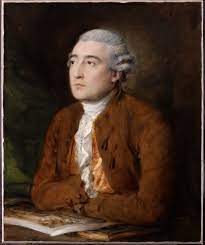
RESEARCH INTO PRACTICE: Notes on Phillippe-Jacques de Loutherbourg

ABOUT LOUTHERBOURG
Philippe-Jacques de Loutherbourg (1740-1812) was a French-born British painter, draughtsman, and stage designer. He was known for his dramatic landscapes, seascapes, and historical paintings, and was one of the leading artists of his time in Britain.
Born in Strasbourg, France, Loutherbourg studied art in Paris before moving to London in 1763. He quickly established himself as a prominent artist in British society, becoming a member of the Royal Academy in 1768 and serving as its president from 1781 until his death. At the same time he worked as a stage designer for David Garrick at the Drury Lane theatre and was the first person to create visual special effects on the stage in London. He made the first fully formed mechanical theatre, the Eidophusikon, a proto-cinema apparatus.
Loutherbourg’s paintings are characterized by their dramatic use of light and shadow and their sense of movement and energy. He was probably the first painter to achieve a realistic sublime paintings that were utterly realistic in their imagery but offered an overwhelming feeling of sublime transcendence. The paintings he did late in life were quite mystical and involved imagery and concepts drawn from SwedenBorg and his own occult practises.
Occultism
Loutherbourg was a serious and dedicated occultist and alchemist. He invented special effects and pigments in his alchemical lab as well as more spiritual alchemical workings. He had a magic circle and engaged in ritual magic. His wife Lucy joined him in his magical endeavours but at the same time also tried to monitor and control his public image as a magician.
Eighteenth-century occultism encompasses various beliefs and practices considered “occult” or hidden during that time. The last third of the 18th century in particular was a busy period for occultists as many grimoires were published or republished at this time
Alchemy was a philosophical and spiritual practice aimed at transforming base metals into gold and discovering the elixir of life. Alchemists believed that matter was composed of the four elements (earth, air, fire, and water) and that these elements could be transformed into one another. Alchemy was often associated with Hermeticism, a philosophical and religious tradition based on the teachings of the ancient Greek philosopher Hermes Trismegistus. Hermeticism emphasized the unity of all things, the interconnectedness of the macrocosm and the microcosm, and the idea that the divine is present in all things. It also emphasized the importance of studying nature, mathematics, and astronomy. Rosicrucianism was a philosophical and spiritual movement that emerged in the early 17th century. It emphasized the importance of spiritual growth, the pursuit of knowledge, and as such influenced European intellectuals like Swedenborg though he was never a Rosicrucian.
LUCY DE LOUTHERBOURG

Lucy was a young widow who married Loutherbourg a few years after he moved to London. The couple appear to not have had any children but formed a strong collaborative relationship. Lucy was deeply involved in all Loutherbourg’s endeavours. She seems to have been a well known figure in London. Loutherbourg was well known for including women as equal partners in his magical practises and for pushing freemasonry to accept women on equal standing with men.
CAGLIOSTRO
Count Cagliostro was a friend and associate of Loutherbourg until they fell out dramatically. , Alessandro di Cagliostro, was an 18th-century occultist and self-proclaimed magician. His ideas and teachings blended various esoteric and mystical traditions of his time, and were influenced by Swedenborg although it is unclear if they ever met in London. While Cagliostro’s ideas were diverse and evolved, here are some key elements that are often associated with his teachings:
Alchemy and Hermeticism: Cagliostro was influenced by alchemical and Hermetic traditions, which emphasized the transformation of the self and pursuing spiritual enlightenment. He believed in a universal life force or energy that could be harnessed for personal growth and healing.
Fremasonry: Cagliostro was involved in Freemasonry and claimed to have attained high degrees within various sects of the organization. He incorporated Masonic symbolism and rituals into his teachings and offered initiations and memberships into his secret society, the Egyptian Masonic Rite.
Cagliostro was known for his self-styled ‘Egyptian Cure’ – a medicinal ritual supposed to offer a full human rejuvenation. He claimed to have been in Egypt where he discovered secret knowledge and initiations from ancient Egyptian sources. He incorporated Egyptian symbolism and rituals into his teachings, presenting himself as a custodian of ancient wisdom and claiming access to hidden knowledge. He also developed an Egyptian Rite for his version of Freemasonry.
Cagliostro promoted various healing practices, including herbal remedies, magnetism, and energy healing. He claimed to be able to heal through manipulating life force energy and advocated for a holistic approach to health and well-being. He taught faith healing to Loutherbourg and Lucy, who opened their own faith healing clinic in London. The clinic was free to the poor, which attracted large crowds until the authorities shut them down.
Cagliostro emphasized the pursuit of spiritual enlightenment and personal transformation. He taught that individuals could attain higher levels of consciousness and spiritual awareness through the practice of his teachings, rituals, and initiations.
It is important to note that Cagliostro’s ideas and practices were controversial and often met with skepticism and criticism during his lifetime. His claims of possessing supernatural powers and secret knowledge led to accusations of fraud and charlatanism. While many were drawn to his teachings and practices, others dismissed him as a fraud or a showman. He was eventually arrested in Italy by the Inquisition and incarcerated until his death; his papers were presumably destroyed.

